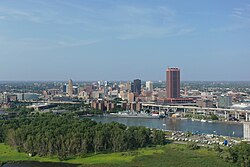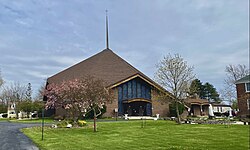
Erie County is a county located along the shore of Lake Erie in western New York State, United States. Erie County makes up, together with along Niagara County, the Buffalo-Niagara Falls metropolitan area, the second largest in the State of New York behind New York City.
Research your ancestors on MyHeritage
History of Erie CountyHistory of Erie County

The first European settlement in what is now Erie County, NYwas a French settlement near the mouth of Buffalo Creek in 1758. The British took control of the area after the French and Indian War in 1763, eventually settling Seneca refugees in villages on Buffalo Creek. The greater Western New York area was acquired by the Holland Land Company around 1800. The area was first known as Ontario County. Genesee County was carved out of Ontario County in 1802, and then divided again in 1808 to create Niagara County. Erie County was created from Niagara County in April 1821.[1]It consisted of all lands between the Tonawanda Creek and the Cattaraugus Creek, including towns of Amherst, Aurora, Boston, Clarence, Collins, Concord, Eden, Evans, Hamburg, Holland, Sardinia, and Wales. Erie County borders Lake Erie, both of which were named for the indigenous Erie tribe, who first inhabited the area.[2]
Statistics of Erie CountyStatistics of Erie County
Erie County currently covers an area of 1,227 square miles (3,180 km²). About 15% of that area is water. The population was estimated at 946,147 in 2023. About 55% of the population is between the ages of 18 and 65, and 77% of the population is white.[3]
Heritage of Erie CountyHeritage of Erie County
The first non-Native inhabitants of the area included migrants from New England. After arriving at East Coast entry points such as Castle Garden or Ellis Island, immigrants to the US moved west across New York State in search of work, family, or land. The opening of the Erie Canal in 1825 transformed Buffalo into a busy port city, and, along with the expansion of the railroad system, made travel to Erie County from New York City ports easier.[4] The German population in the area swelled around 1830, and by the 1850's Buffalo's Fruit Belt neighborhood was growing. It was named because of the fruit trees which filled the yards of the German settlers, and was the city's longest standing German community.[5]
The next waves of immigrant settlers included those from Poland, Italy, and Ireland.[6] Later years saw Hungarian, Ukrainian, Armenian, Puerto Rican, and Burmese immigrants. African-Americans arrived in greater numbers during the Great Migration from America's south.[7] As of 2022, approximately 7% of Erie County's population was born outside of the United States.[8]
Religions in Erie CountyReligions in Erie County

Churches assisted new immigrants not only in getting settled in their new country, but also by keeping them connected with others from their birth country.[9] The earliest Europeans to populate the area included Catholic missionaries. Following Britain's victorious outcome in the French and Indian War in 1763, Catholicism fell out of favor, replaced by the Anglican Church. In fact, there was a law in place after the Revolutionary War prohibiting the offering of aid or shelter to Catholic priests.[10] A wave of German-speaking settlers brought Catholicism back to the area beginning in the 1820s. Many worshipped at St. Louis Church, Western New York's first Catholic church, which was established in 1829.[11] St. Louis served not only Germans, but also Polish, Italian, and Irish Catholics. The area was also home to Episcopal, Presbyterian, Lutheran, Baptist, and Protestant churches.[12] Congregation Ahavas Sholem formed in 1890 as an orthodox synagogue in Buffalo.[13]
Industry in Erie CountyIndustry in Erie County
The construction of the Erie Canal made the shipping of goods easier, allowed people to travel more quickly, and created jobs. This in turn lowered prices on incoming materials and goods, such as lumber, and gave farmers and manufacturers of finished goods an outlet to sell their goods. Many locals worked on the Canal during its construction, as well as recent immigrants, particularly Irish.
Like the Erie Canal, railroads made the movement of people and goods easier and less expensive, and opened up new markets for the sale of finished goods and new sources of raw goods for use in manufacturing. Railroads had an advantage over the Canal, though, in that they could travel inland. In 1897, 27 railroads served the Erie County area.[14] At the apex of the area's railroad era, more than 24,000 people were employed by railroads in the area.[14] Railroads also carried mail across the country, allowing families to keep in touch more regularly as they migrated.[15]
Bethlehem Steel, located in Lackawanna, NY, used the railroads to bring in raw materials and ship out finished goods. The steel industry had a significant economic impact on the area. During the peak of facility's production in the 1950s - 1970s, as many as 20,000 people were employed in and around the plant at any given time.[16] People relocated to the area to find work there as jobs dried up elsewhere.
Agriculture was and continues to be an important industry in Erie County. Much of the area was farmland as the first European immigrants arrived, and they continued to produce the fruits, vegetables, meats, and grains consumed in the area. As of 2017, there were 940 farms in Erie County, a total of more than 140,000 acres,[17] including several multi-generational family farms.[18] Both the Erie Canal and the railroads aided farmers by allowing them to ship their goods outside the area.
See alsoSee also
Explore more about Erie CountyExplore more about Erie County
- The New York - Collection Catalog at MyHeritage contains many records pertaining to Erie County
- The Erie Canal and the Opening of the Midwest webinar at Legacy Family Tree Webinars
- Erie County, NY Project Dashboard at Geni
References
- ↑ Chapter XXI: From Formation of Erie County Until 1830 (pages 190-207). History of the City of Buffalo and Erie County ; With Illustrations and Biographical Sketches of Some of its Prominent Men and Pioneers In Two Volumes. Volume 1, History of Erie County. New York Heritage Digital Collections
- ↑ ERIE INDIANS. Encyclopedia of Cleveland County
- ↑ Erie County, New York. United Census Bureau
- ↑ Buffalo’s Neighborhoods: Exploring Our Migrant & Immigrant Heritage. New York Heritage Digital Collections
- ↑ The Fruit Belt | New York Heritage
- ↑ https://www.townofhamburgny.gov/485/History
- ↑ A timeline of immigration in Buffalo. Buffalo Spree
- ↑ Erie County, NY. DATAUSA
- ↑ Buffalo’s East Side Deutschtum | New York Heritage
- ↑ Buffalo's Catholic Churches
- ↑ St. Louis - Buffalo's Oldest Catholic Church. Hello Buffalo!
- ↑ Buffalo's Historical Churches (Self Guided), Buffalo, New York
- ↑ Ahavas Sholem. Jewish Buffalo History Center
- ↑ 14.0 14.1 Erie County Railroads: 1836-1972. NYLearns
- ↑ Erie Railroad Rochester Division: Chapter Three. Rochester & Genesee Valley Railroad Museum
- ↑ When Steel was King. Buffalo Tales
- ↑ Erie County. USDA
- ↑ [1]

